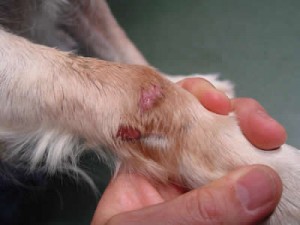 Acral lick dermatitis (ALD), also known as a lick granuloma, is a frustrating disease. Typically, these skin lesions appear on the front of the foreleg, close to the carpus. Though ALD was historically considered to be a boredom and stress induced disease, a wide array of inciting causes are now recognized.
Acral lick dermatitis (ALD), also known as a lick granuloma, is a frustrating disease. Typically, these skin lesions appear on the front of the foreleg, close to the carpus. Though ALD was historically considered to be a boredom and stress induced disease, a wide array of inciting causes are now recognized.
ALD is a disease of older, large-breed dogs. Most cases occur in Doberman Pinschers, Great Danes, Golden Retrievers, Labrador Retrievers, German Shepherds, and Boxers, although ALD has also been reported in other breeds.
 The hallmark of ALD is an area of thickened, hairless skin, eroded on the surface because of constant licking. Exposure of sensory nerve endings is thought to cause the pruritis (itch). There is a vicious cycle of licking to alleviate the itch which further irritates the skin, which causes more itching.
The hallmark of ALD is an area of thickened, hairless skin, eroded on the surface because of constant licking. Exposure of sensory nerve endings is thought to cause the pruritis (itch). There is a vicious cycle of licking to alleviate the itch which further irritates the skin, which causes more itching.
The treatment of ALD begins with an understanding of the primary disease that initiated the lesion and the factors that have perpetuated it. For example, a small wound may be the primary (triggering) factor, but continuous licking creates a skin infection which perpetuates the disease.
In the Great Dane and Doberman Pinscher, psychological factors definitely play a role – boredom or stress can trigger licking. In other breeds, allergies more commonly lead to compulsive licking.
Infection is a perpetuating factor that makes resolution of ALD difficult. For this reason, most veterinarians include an antibiotic in their treatment protocols. The learned behaviour of licking can also be a perpetuating factor itself. Continued physical irritation from licking will impede healing even if the primary or other perpetuating causes have been eliminated. Some dogs need psychoactive drugs to help break the cycle. Contrary to past opinions, use of these drugs alone is rarely effective.
In some cases, the only way to permanently resolve an ALD lesion is to do tests to establish the primary cause. Some dermatologists begin by doing routine blood work and urine tests to rule out any underlying metabolic disease. Others proceed directly to cultures for fungi and skin scrapings for parasites. A skin biopsy of an ALD lesion is useful to confirm the presence of an infection and to make sure there is no cancerous component. If there is a possibility of pain-causing bone pathology or arthritis underlying the skin lesion, radiographs are indicated. Skin allergy testing may be worthwhile if the history suggests an allergy.
Because there are so many causes of ALD, there is no one therapy that will cure all cases. The first, and most important step of treatment, is to prevent licking. Bandaging is rarely effective because most dogs will chew it off. Elizabethan collars, though inconvenient for the dog, can be effective.
The next step is to control the skin infection with antibiotic therapy. In chronic cases, antibiotics must be administered for a prolonged period – often for months. Antibiotic selection is ideally based on culture of the bacterium and susceptibility testing. Topical treatment with antibiotics and anti-pruritic ointments has also been attempted and these must be used for an initial period of four to six weeks.
Surgery is reserved for those ALD lesions with a suspected foreign body or those with underlying bone pathology. Simply excising the lesion will not prevent recurrence because the primary disease has not been eliminated.
An injection of steroids into the lesion was historically a preferred treatment for ALD. Today, dermatologists do not recommend this approach. It may allow further bacterial growth by lowering immunity.
Acupuncture has recently been used to treat ALD. Needles inserted at the periphery of the lesion in a technique called “circle the dragon” are left in place for 15 minutes or longer. Alternatively, vitamin B can be injected around the wound (aquapuncture). In some cases, this modality works well, but its success rate is inversely related to chronicity. Laser therapy is the new kid on the block and it is showing promise in resolution of these lesions. As with all treatments, lesions that have been present for an extended time are less likely to resolve.
The similarities between ALD and obsessive-compulsive disorders are striking. In both, there is recurrent, persistent, unnecessary behaviour. Some researchers believe that ALD is a manifestation of exaggerated grooming habits which suggests antidepressant medications may work. Clomipramine (marketed as Clomicalm in Canada) has shown some efficacy in the treatment of ALD. Other drugs also show promise, but with all these psychogenic medications, there is a lag phase of at least four weeks before there is a reduction in the excessive grooming behaviour.
Dr. Louise Janes D.V.M. & Dr. Jeff Grognet D.V.M.
 Mid-Isle Veterinary Hospital
Mid-Isle Veterinary Hospital
5-161 Fern Road West
Qualicum Beach, BC
Tel (250) 752-8969
See all articles by Dr. Louise Janes D.V.M. & Dr. Jeff Grognet D.V.M.



